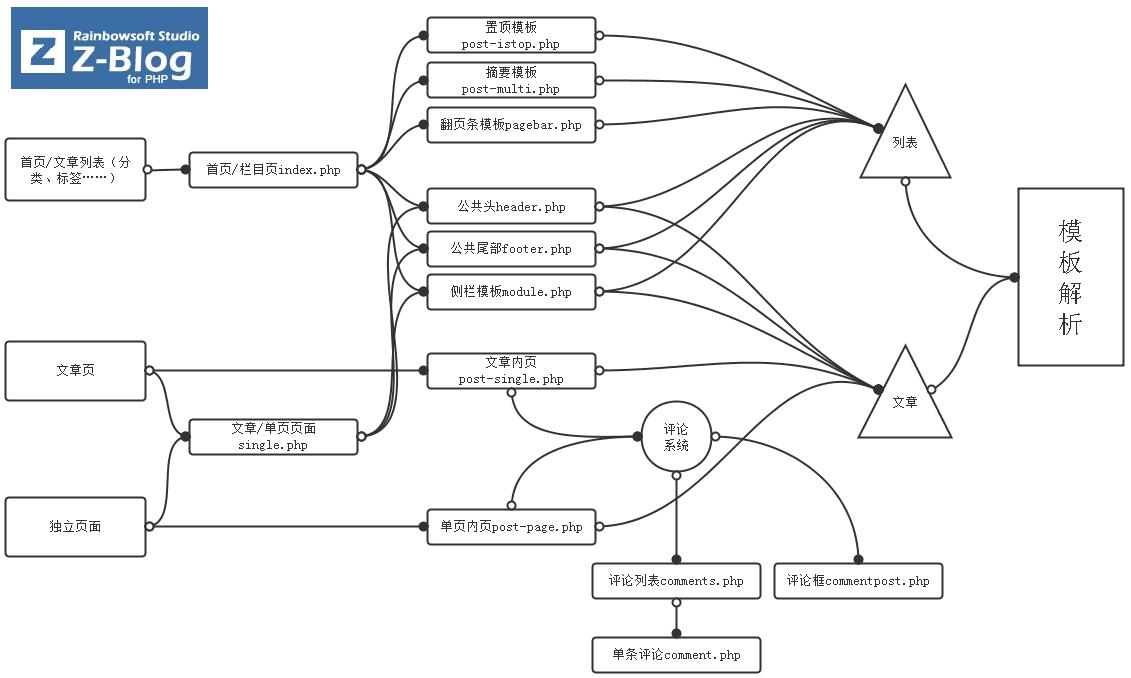
同分类文章列表调用
{foreach GetList(调用条数,分类ID) as $related}<li><span>{$related.Time('Y-m-d')}</span><a href="{$related.Url}">{$related.Title}</a></li>{/foreach}
获取大目录下的所有文章(包括子目录文章):
{foreach Getlist(调用条数,分类ID,null,null,null,null,array('has_subcate'=>true)) as $related}<li><span>{$related.Time('Y-m-d')}</span><a href="{$related.Url}">{$related.Title}</a></li>{/foreach}
调用其它数据参考php/133.html" target="_blank" style="box-sizing: border-box; color: rgb(160, 206, 78); background-color: transparent; text-decoration: none;">文章标签。
注意:此处需要使用foreach循环中as后面变量名,如案列中使用的$related,如需调用标题则用{$related.Title},而并非是 {$article.Title}。
网站关键词、描述添加
{if $type=='article'} <title>{$title}_{$article.Category.Name}_{$name}</title>
{php}
$aryTags = array();
foreach($article->Tags as $key){
$aryTags[] = $key->Name;
}
if(count($aryTags)>0){
$keywords = implode(',',$aryTags);
} else {
$keywords = $zbp->name;
}
$description = preg_replace('/[\r\n\s]+/', ' ', trim(SubStrUTF8(TransferHTML($article->Content,'[nohtml]'),135)).'...');
{/php} <meta name="keywords" content="{$keywords}"/>
<meta name="description" content="{$description}"/>
<meta name="author" content="{$article.Author.StaticName}">{elseif $type=='page'} <title>{$title}_{$name}_{$subname}</title>
<meta name="keywords" content="{$title},{$name}"/>
{php}
$description = preg_replace('/[\r\n\s]+/', ' ', trim(SubStrUTF8(TransferHTML($article->Content,'[nohtml]'),135)).'...');
{/php} <meta name="description" content="{$description}"/>
<meta name="author" content="{$article.Author.StaticName}">{elseif $type=='index'} <title>{$name}{if $page>'1'}_第{$pagebar.PageNow}页{/if}_{$subname}</title>
<meta name="Keywords" content="自定义关键词,{$name}">
<meta name="description" content="自定义描述_{$name}_{$title}">
<meta name="author" content="{$zbp.members[1].StaticName}">{else} <title>{$title}_{$name}_第{$pagebar.PageNow}页</title>
<meta name="Keywords" content="{$title},{$name}">
<meta name="description" content="{$title}_{$name}_当前是第{$pagebar.PageNow}页">
<meta name="author" content="{$zbp.members[1].StaticName}">{/if}
评论数判断
{if $article.CommNums==0}
暂无留言
{elseif $article.CommNums==1}
仅有1条留言
{else}
已有{$article.CommNums}条留言
{/if}
页面判断
{if $type=='index'&&$page=='1'} /*判断首页*/
{if $type=='category'} /*判断分类页*/
{if $type=='article'} /*判断日志页,不含独立页面,{if $article.Type==ZC_POST_TYPE_ARTICLE}(另一方案)*/
{if $type=='page'} /*判断独立页面*/
{if $type=='author'} /*判断用户页*/
{if $type=='date'} /*判断日期页*/
{if $type=='tag'} /*判断标签页*/
示例:首页和分类列表页分离
在index.php文件里作判断,分离模板。比如:
{if $type=='index'&&$page=='1'}
{template:c_index}
{else}
{template:c_list}
{/if}
然后新建两个相应的模板文件:c_index.php和c_list.php
随机获得文章中的四张图片中的一张
适用于多图站点,在模板文件中使用:
{php}
$temp=mt_rand(1,4);
$pattern="/<[img|IMG].*?src=[\'|\"](.*?(?:[\.gif|\.jpg|\.png]))[\'|\"].*?[\/]?>/";
$content = $article->Content;
preg_match_all($pattern,$content,$matchContent);
if(isset($matchContent[1][0]))
$temp=$matchContent[1][0];
else
$temp=$zbp->host."zb_users/theme/$theme/style/images/random/$temp.jpg";
//需要在相应位置放置4张jpg的文件,名称为1,2,3,4
{/php}
<img src="{$temp}" />
仅显示文字的文章简介调用方法
{SubStrUTF8(TransferHTML($article.Intro,"[nohtml]"),200)}
分类目录面包屑的代码编写
{php}
$html='';
function navcate($id){
global $html;
$cate = new Category;
$cate->LoadInfoByID($id);
$html ='>> <a href="' .$cate->Url.'" title="查看' .$cate->Name. '中的全部文章">' .$cate->Name. '</a> '.$html;
if(($cate->ParentID)>0){navcate($cate->ParentID);}
}
navcate($article->Category->ID);
global $html;
echo $html;
{/php}
显示相关文章
搜索$article的相关文章(ZC_RELATEDLIST_COUNT选项默认为10)
PHP
$array=GetList($zbp->option['ZC_RELATEDLIST_COUNT'],null,null,null,null,null,array('is_related'=>$article->ID));
在模板中,获取并输出获取到的相关文章代码参考如下
{$array=GetList($zbp->option['ZC_RELATEDLIST_COUNT'],null,null,null,null,null,array('is_related'=>$article->ID));}<ul id="related">{foreach $array as $related} <li>
<span class="time">{$related.Time('m-d')}</span>
<span class="title"><a href="{$related.Url}" title="{$related.Title}">{$related.Title}</a></span>
</li>{/foreach}</ul>



 。
。 



